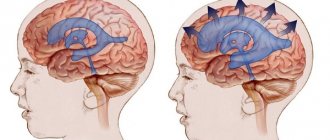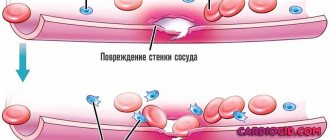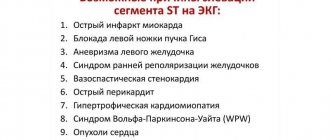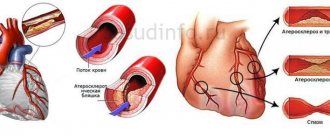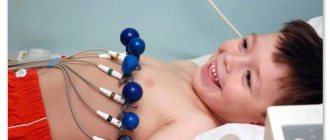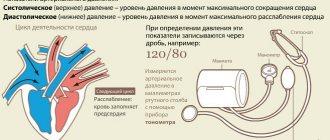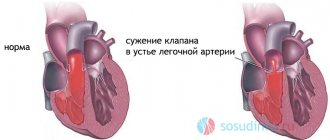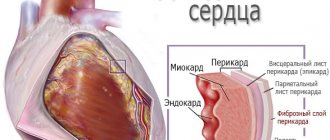Cerebral hypertension is a dangerous disease, during the development of which there is an increase in pressure in the intracranial cavity. This is a syndrome of increased intracranial pressure. The formation of this pathological process can be triggered by various factors (injuries, specific diseases, metabolic problems, intoxication, etc.). Intracranial hypertension should not be confused with hypertension (arterial hypertension) and hypotension (pathological decrease in blood pressure).
Regardless of the causes, intracranial hypertension (ICH) will have very characteristic symptoms, expressed by severe, bursting headaches. The pain syndrome is often combined with nausea, vomiting, deterioration of vision, memory and intellectual abilities.
Signs, manifestations and main symptoms of intracranial hypertension in children and adults will depend on the causes of the disease and the duration of development of the pathological condition. To diagnose this disease, special examination techniques are used. Doctors can treat hypertension with surgical intervention or in a moderate conservative way (depending on the indications and the person’s condition).
Causes
There are many known causes of liquor hypertension, but it is customary to highlight the most famous and regularly occurring ones:
- due to encephalitis and meningitis, dropsy may occur in the brain;
- disruption of the jugular veins;
- diseases causing cerebral edema;
- lung lesions, which are accompanied by edema;
- development of a malignant tumor or hematoma inside the skull; a hematoma can occur after a strong blow to the head or a hemorrhagic stroke, after which the hematoma begins to put pressure on the brain tissue, which leads to their enlargement;
- liquor hypertension also occurs in children; it can be caused by prematurity, infections, various pathologies during pregnancy; it is possible that the newborn will develop other brain defects;
- congestive heart failure.
Doctors may have problems making a diagnosis, since this disease does not always present pronounced signs. For timely and high-quality treatment, when examined by a doctor, you must describe your symptoms in detail. To eliminate intracranial pressure, it is necessary to weaken the factors that provoke the central nervous system.
ICH in children
If there are symptoms of intracranial hypertension in children, treatment should be carried out immediately. Doctors can use any means and possibilities to prevent the development of hypertensive-hydrocephalic syndrome. Pathology in newborns and young children can occur against the background of difficult labor and pregnancy, intrauterine infections, hypoxia, and congenital pathologies.
It is often quite difficult to detect symptoms in children under 1 year of age that would correspond to intracranial hypertension. Typically, this type of disease in babies manifests itself in the form of a poor sucking reflex. Also, such children have increased head volume, they often experience vomiting for no reason, there is increased drowsiness, and the perifontanelle veins are prominent. Older children are characterized by more specific symptoms:
- Periodic headaches of varying severity.
- Insufficient (for the age of a particular child) physical activity.
- Poor vision, increased fatigue, anxiety.
Intracranial hypertension for young children is dangerous because it can ultimately lead to developmental retardation, mixed hydrocephalus, blindness, and paralysis. In recent years, there have been many reports of young children being diagnosed with ICH after receiving the DTP vaccine.
Symptoms
Symptoms of intracranial pressure may vary in adults. It all depends on the provoking factor, the degree of damage to the brain and the patient’s body. The main symptoms that occur with liquor hypertension are identified:
- Hot temper, imbalance, nervousness, regular mood swings.
- Morning sickness with possible vomiting.
- The appearance of constant fatigue, which is present even with excessive rest and minor mental and physical stress.
- The condition of the body depends on the weather. As it turns out, this is also a symptom of liquor hypertension. Deterioration of the condition with a sharp change in weather and a significant decrease in atmospheric pressure.
- The appearance of swelling and bruising under the eyes. With liquor hypertension, such manifestations occur even with healthy sleep and proper management of your day and activity. These bruises are accompanied by significant vasodilatation.
- At night or in the morning, headaches and a heaviness of the head occur. This is a consequence of excessive secretion of intracranial fluid, which is slowly absorbed. This leads to pressure on the skull and pain in the head.
- Excessive sweating and increased heart rate during exercise.
And the main symptom of intracranial pressure in adults is sudden changes in blood pressure. If you have such a pathology, you should immediately visit a specialist.
Electroencephalography
As a rule, this method is intended to identify the chronic nature of the disease. The study itself proceeds as follows: the patient is located in a room as isolated as possible from external noise and light. The examinee puts on a special cap. First, the patient blinks at the doctor’s request. Then he must sit still for a while. After this stage, the patient is required to breathe deeply. Finally, for the final check, the doctor directs a light source at the person being examined, which “blinks” approximately twenty times per second. This concludes the examination.
First aid
If intracranial pressure increases rapidly, the patient's life is in danger. In this case, resort to urgent first aid measures for liquor hypertension. Thus, it is recommended to administer hyperosmolar solutions into a vein, emergency intubation and artificial ventilation of the lungs in hyperventilation mode. In some cases, the patient is put into a medically induced coma (with the help of barbiturates). Using a puncture, excess amounts of cerebrospinal fluid are removed. The most aggressive measure is decompressive craniotomy. It is only done in extreme situations. The essence of the procedure is to create a defect in the skull on one or both sides so that the brain does not “rest” against the bones of the skull.
Treatment
Therapy is usually medication. The use of a group of pharmaceuticals is indicated.
- Diuretics. Diuretics are prescribed to quickly relieve attacks. They are also used systematically as part of therapy. The most actively prescribed thiazide names (Hypothiazide and others). Loops are indicated in acute cases (Furosemide and analogues).
Caution:
Concomitant use of potassium-sparing medications is recommended to negate the removal of electrolytes.
- Cerebrovascular. To normalize brain nutrition. Piracetam as the main one. It is possible to prescribe Actovegin. If there is no intolerance to the drug.
- Nootropics. Accelerate metabolic processes in cerebral structures. Glycine, Phenibut. You cannot take them without permission, especially if there are brain tumors.
- Venotonics. For blood stagnation (medicines based on diosmin and hesperidin).
Massage also worked well. It is carried out by a qualified specialist and forms part of a comprehensive treatment.
In urgent cases, surgery for direct drainage and removal of excess fluid is possible. This is a last resort. This procedure is carried out in a neurosurgical department.
Drug therapy
Treatment of liquor hypertension, the signs of which are mentioned above, is carried out only after determining the direct factor of the disease. This is due to the fact that certain pharmaceuticals can help a patient with one factor of intracranial pressure and may be completely useless with another. After a clear diagnosis is established, the main disease is treated first. For example, if a brain tumor or hematoma occurs, surgical treatment is resorted to. Elimination of a tumor or bleeding (with a hematoma), as a rule, leads to normalization of intracranial pressure without any accompanying measures. If inflammation is a factor in the increase in intracranial pressure, then massive antibiotic therapy becomes the main means of treatment.
Symptomatic medications that reduce intracranial pressure include diuretic substances of various chemical groups. Therapy begins with them in cases of benign hypertension. More often used are Furosemide (Lasix), Diacarb (Acetazolamide). Furosemide is best used in a short course (when prescribing Furosemide, potassium supplements are used in addition), and Diacarb is prescribed in different regimens, which is selected by the doctor. "Diacarb" for benign intracranial hypertension is prescribed in intermittent courses of 4 days, with a further interval of 1-2 days. It not only removes excess fluid from the cranial cavity, but also reduces the production of cerebrospinal fluid, thereby lowering pressure.
General description of the disease
The brain is located in a bone structure, inside which the organ is placed in a liquid medium that performs an additional protective function. Fluid environments, the ventricles, are also localized in the skull. CSF (exudate, cerebrospinal fluid) acts as a protective fluid. It is the cerebrospinal fluid that creates intracranial pressure.
Interesting! Intracranial hypertension syndrome was first characterized by the concept proposed by Monroe-Kelly.
The ventricles and fluid locations are interconnected by ducts through which exudate circulates. Spinal fluid is renewed up to 7 times a day
. If excretion, absorption or patency of exudate is impaired, ICH develops.
The human brain is structurally divided into matter, blood, exudate and interstitial fluid. The components have a specific volume and are separated from each other by an encephalopathic barrier. In a healthy person, all elements are balanced with each other. If the volume of one component is disrupted, intracranial pressure increases in the entire cerebral cavity.
Traditional methods
First of all, before starting self-medication, you need to consult a specialist. After all, traditional methods of therapy will help reduce pain and help lower blood pressure, but they will not be able to completely eradicate the disease itself. In any case, tinctures and various decoctions will give a positive effect and help relieve pain. Below are folk remedies that are effective in getting rid of unpleasant and painful symptoms.
Treatment with decoctions:
- A decoction of dried lavender. 1 teaspoon of dried lavender per glass of boiling water. The decoction is infused for about an hour. The decoction is taken 1 tablespoon per day. The treatment lasts for a month, after which you should take a break of 2 weeks. And again drink the decoction for a month.
- A decoction of valerian, hawthorn and motherwort. 1 teaspoon of each dried plant per 0.5 liter of boiling water. Let it brew for an hour, drink half a glass before meals.
- Honey-pine decoction. Chop 100 grams of young shoots, add 1 liter of water and cook for about an hour. Strain the broth and add 500 grams of honey. Drink half a glass 2 times a day for two months.
- Viburnum decoction. Pour boiling water over 200 grams of viburnum and let it brew for an hour in a closed container. Strain. Drink half a glass 3 times a day.
Treatment with tinctures:
- Clover tincture. You will need 2 tablespoons of dried inflorescences and 0.5 liters of any vodka. Leave the mixture for 2 weeks, shaking occasionally. Take 1 teaspoon of infusion before meals.
- Infusion of honey and onion juice. You will need 3 kilograms of onions, 500 grams of honey, approximately 25 grams of walnut partitions and 0.5 liters of vodka. The onion must be passed through a juicer. Mix onion juice with 500 grams of honey, adding 25 grams of nut partitions to this mixture. Pour the resulting mixture into 0.5 liters of vodka and let it brew for 2 weeks. Use 1 tablespoon 3 times a day.
- Plantain infusion. Boil 3 tablespoons of dried leaves in 0.5 liters of water for about 10 minutes. Infuse, then strain. Consume 50 grams daily 3 times.
- Lemon and garlic infusion. First peel the garlic and wash the lemon. Pass the ingredients through a juicer and add boiling water. Leave for a day. Drink 50 grams at night for a whole month, then take a break.
Application of compresses:
- Compress soaked in camphor oil and medical alcohol. To do this, you need to mix 50 milliliters of medical alcohol and camphor oil. Rub the prepared tincture into your head. For full effect, you should insulate it with a towel. Keep the bandage on for several hours. This procedure can be performed 10 times a month.
- Honey compress. Honey and pollen are taken in proportions of 1 to 2. Place in a jar and store at room temperature. Rub into head, cover with a towel. Carry out this procedure daily for a month.
- You can also drink birch sap 3 times a day. The juice can prevent high blood pressure and have beneficial effects as a vitamin complex.
How to relieve pain?
For prevention, it is recommended to perform a head massage. It will not only help prevent disease, but also relieve pain and increasing pressure.
Also, to reduce headaches, which often accompanies an increase in intracranial pressure, you can use a magnesium-based recipe. The product has a pronounced diuretic effect, due to which the pressure on the brain structures is reduced and pain is removed.
For 50-80 g of hot boiled water you will need a tablespoon of magnesium sulfate in powder form. When it is completely dissolved, the drink must be drunk at once. After 5 min. After taking the medication, you need to take fish oil, which will make it possible to prevent excessive blood thickening.
What needs to be examined
Diagnosis is carried out on an outpatient or inpatient basis. The task is to identify not only the violation itself, but also its culprit.
The problem is that there are no specific assessment measures, so doctors have to be insightful and draw conclusions in the face of limited information.
Possible activities include:
- Oral questioning of the patient or his parents. All health complaints are identified. The symptomatic complex is assembled in parts. Further, it is already possible to draw intermediate conclusions.
- Anamnesis collection. Past illnesses, current diagnoses, habits. Lifestyle, professional activity and other points. As part of identifying a possible cause, the etiology of the process.
- EEG. Encephalography indicators provide indirect signs of intracranial hypertension: a decrease in the activity of certain areas of the brain or, conversely, an increase in it. But the information is sketchy; the methodology is only suitable for a comprehensive assessment.
- X-ray. Provides data only at advanced stages of the disease.
- MRI diagnostics. It also does not allow us to say anything concrete until the condition is sufficiently “ripe”.
- The doctor must conduct a routine neurological examination. Evaluates reflexes.
- In particularly controversial cases, an invasive procedure is possible: puncture. It is used extremely rarely.
Attention:
Making a diagnosis of intracranial hypertension creates a lot of difficulties. The best solution, especially if the discomfort is severe, is hospitalization.
